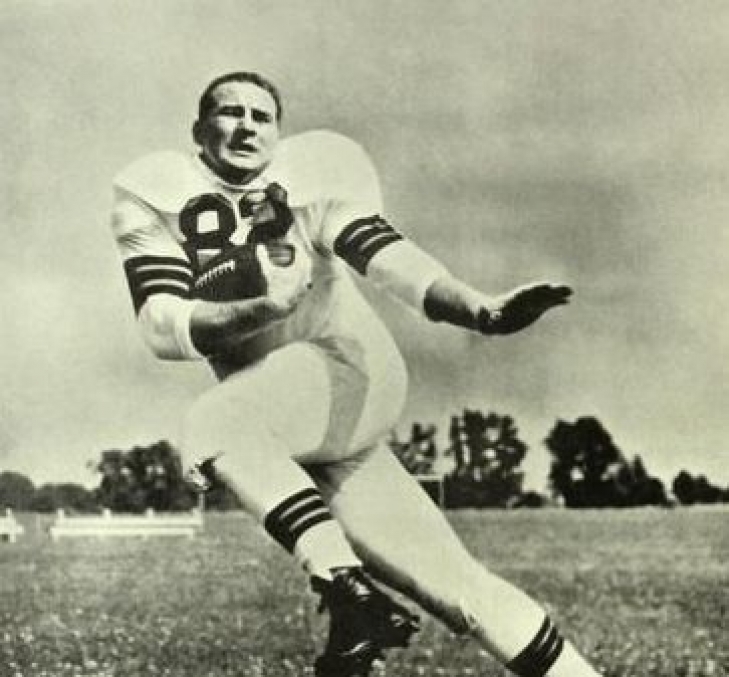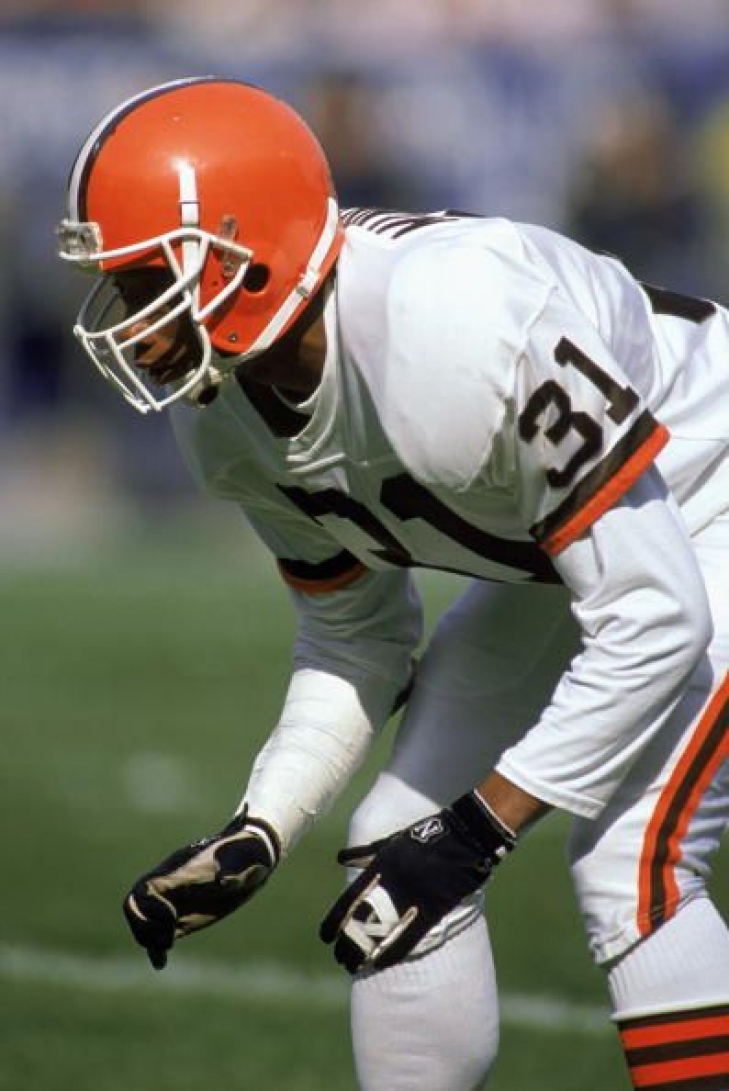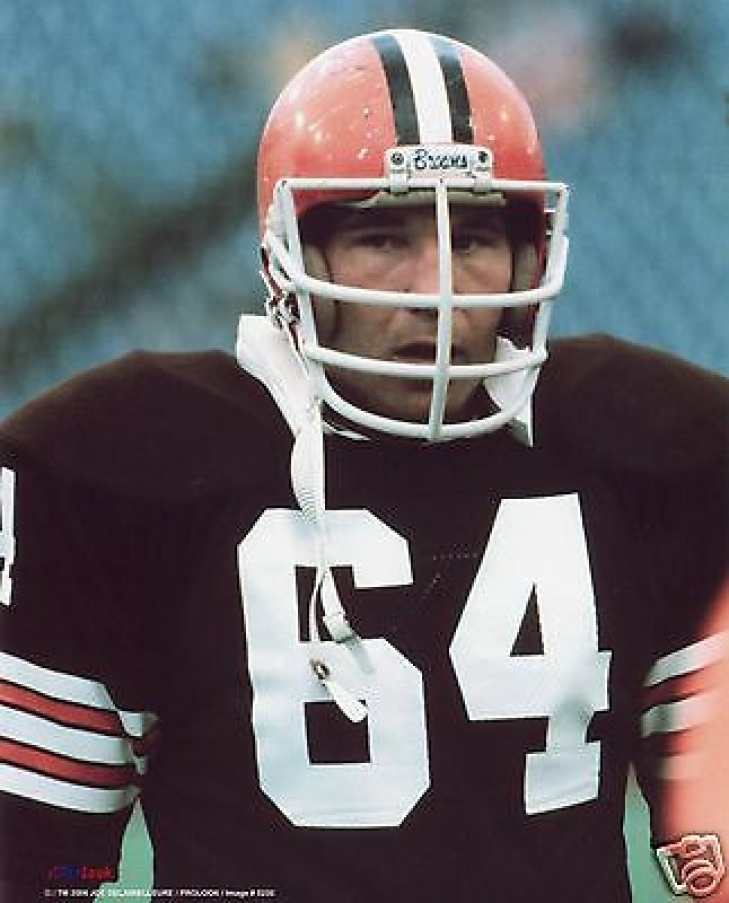18. Ray Renfro
Taken in the 4th Round from North Texas, Ray Renfro was one of the many players that Paul Brown acquired who turned out to be a hidden gem.
Renfro played his entire 12-year career with the Browns, with the middle ten as one of the better Flankers in football. A three-time Pro Bowl Selection, Renfro led the NFL in Receiving Yards per Game in 1955 and accumulated 5,508 Receiving Yards over his career, an excellent tally for his era. Renfro proved to be a key part of two NFL Championships (1954 & 1955).
He would later win a Super Bowl as the Quarterbacks/Wide Receivers Coach for Dallas. The Browns named Renfro to their legends list in 2001.
42. Bill Glass
A member of the College Football Hall of Fame for his work at Baylor, Bill Glass began his pro career in Detroit, but four years later, in 1962, he was traded to Cleveland, which proved to be beneficial for the Defensive End.
In his first year as a Brown, Glass became Cleveland's top pass rusher, accruing 15.5 Sacks and going to his first Pro Bowl. Glass again was a Pro Bowler the next two seasons and was a big part of their 1964 NFL Championship.
Glass set a personal best in 16.5 Sacks in 1965 and had 15 the following year. Again with double-digits in Sacks (10.5) in 1967, Glass earned his fourth Pro Bowl. Retiring in 1968, Glass had 77.5 Sacks for the Browns, and Cleveland listed him as one of their Legends in 2007.
41. Abe Gibron
Abe Gibron played his first year of pro football (1949) with the original Buffalo Bills of the AAFC, but that would be the last year of the upstart league, and the Bills were not one of the organizations that would merge with the NFL. A deal was struck with the Browns, and the outgoing Bills ownership sent Gibron and two other players to Cleveland in exchange for a small portion of club ownership.
It was a fantastic landing place for Gibron, who helped the Browns win the 1950 NFL Championship as a backup Guard. As his game improved, Gibron generated a four-year run of Pro Bowls (1952-55), with him playing critical roles in the 1954 and 1955 Titles.
Gibron was released the following year, and he continued to play on with stints in Philadelphia and Chicago. The Browns would induct him as one of their team Legends in 2015.
40. Mike Pruitt
A star at Purdue, Mike Pruitt only had to travel one state east when the Browns drafted him in the Second Round in 1976. Pruitt did not have a lot of playing time early on, but after receiving more playing time in 1978, the Fullback was poised for a breakout.
In 1979, Pruitt had the best year as a pro, posting what would be personal bests in Rushing Yards (1,294) and Yards From Scrimmage (1,666) and a trip to the Pro Bowl was his reward. Pruitt went to the Pro Bowl again in 1980, again going over 1,500 Yards from Scrimmage.
The Pro Bowls were over for Pruitt, but not the production. He again had over 1,500 YFS in 1981, and in 1983, Pruitt had his fourth 1,000-yard rushing year with the Browns.
Pruitt slowed down afterward and would be released before the 1985 Season. With Cleveland, Pruitt collected 8,301 Yards From Scrimmage and was named a Legend by the team in 2004.
39. Jim Houston
Another product of Ohio State who became a Cleveland Brown, Jim Houston was a First Rounder in 1960, and the Linebacker became a starter during his rookie year.
The Browns in the 60s were known more for their explosive offense, but it was players like Houston that were needed to keep the balance on the other side. Houston was a member of the 1964 NFL Championship Team, and individually, he earned four Pro Bowls and the nickname of Mr. Dependable".
Houston played until 1972, all of which were as a Brown. Statistically, he had 14 Interceptions and 29.5 Sacks, and Cleveland would call Houston's name as one of their Legends in 2006.
38. Tommy James
A collegiate player at Ohio State, Tommy James played with the Detroit Lions of the NFL in his rookie year, but he was cut following a year with a broken arm. Like Brown did with many former Buckeyes, Paul Brown signed James, and he would make the Cleveland Browns for the 1948 Season.
James was a good Defensive Back who helped Cleveland win the last two AAFC Championships and the 1950 NFL Championship when the leagues merged. Named to the Pro Bowl in 1953, James would win two more Titles in 1954 and 1955 while picking off QBs for 34 Interceptions. The Browns would name James as one of their Legends in 2004.
37. Clarence Scott
An All-American at Kansas State, Clarence Scott was the recipient of Cleveland’s First Round Pick (14th Overall) in 1971, and it was with the Browns that he would spend his entire 13-year career.
Scott started at Cornerback, and he would record at least two Interceptions every year except for 1972. A Pro Bowler in 1973, Scott cracked the five-pick mark that year and had four other years with four.
Scott would move to Safety in the last five years of his career but remained a starter until his final year in 1983. Scott would have 39 Interceptions over his career, and in 2012, the Browns named him as one of their Legends.
35. Greg Pruitt
Greg Pruitt was a bit undersized (180lb), but when you are a two-time All-American (and eventual College Football Hall of Famer), the NFL will still call, which in his case were the Browns with a high Second Round Pick in 1973.
In his rookie year, Pruitt was used as a backup Running Back and was a Pro Bowl as a returner, and it was much of the same as a sophomore, though he played more at Running Back, setting up what was to come. In 1975, Pruitt was now the starting RB, and that year and the two that followed saw the former Sooner hit 1,000 Yards, and a third and fourth Pro Bowl (1976 & 1977). Pruitt slowed down afterward, and eventually lost his starting role, though he was still a productive force for Cleveland.
After the 1981 Season, Pruitt joined the Los Angeles Raiders, mainly as a returner, and would win a Super Bowl Ring. With the Browns, Pruitt had 10,700 All-Purpose Yards. Later, in 2001, Pruitt was one of the first four former Browns named to their legends category.
34. Chip Banks
The Cleveland Browns got exactly what was advertised when they took the USC Linebacker with the number three pick in 1982.
Banks was electric as a rookie, winning the Defensive Rookie of the Year with the first of what would be four Pro Bowls in five seasons. Banks also was a First Team All-Pro (1983), and from 1982 to 1986, he was in the discussion as one of the best Linebackers in the business.
Likely sensing potential contract issues, Banks was traded to San Diego, where he wound up sitting out the 1988 Season when he held out. With the Browns, Banks had 27.5 Sacks, and in four of his five seasons, he had an Approximate Value of double digits.
33. Jerry Sherk
Unlike the 1950s and 1960s, the 1970s were not the glory days of the Cleveland Browns, but they did have some bright spots, one of which was Defensive Tackle Jerry Sherk.
Sherk was a Brown for the entirety of his 12-year career, winning the starting job on the right side as a rookie. He would grow into one of the top pass rushers for the Browns through the decade, exceeding the 10-Sack plateau four times, accruing 70.5 in total. From 1973 to 1976, Sherk was a Pro Bowl honoree, with the last four years seeing the former Oklahoma State Cowboy capture First Team All-Pro honors. That year, he was so good that the NEA (Newspaper Enterprise Association) named him the Defensive Player of the Year. The Browns named him as one of their Legends in 2005.
26. Frank Minnifield
After a promising career at Louisville, Frank Minnifield was not drafted by any NFL team, but he landed employment with the Chicago Blitz of the USFL. As the team migrated to Arizona, he proved himself NFL worthy, though he had to sue his way out of the fledgling league. Once he did, the Cleveland Browns were waiting.
Minnifield was an All-Rookie starter at Cornerback, and by his third year, he was named to his first of four Pro Bowls. In the last half of the 1980s, Minnifield was one of the best at his position, and he was a First Team All-Pro in 1988 and a Second Team Selection in 1987 and 1989. Known for his devastating hits, Minnifield was a favorite of the Browns fans, and he remains one of the more popular figures in team history.
Minnifield was injured for most of the 1990 season, and he was not the same player afterward. He remained with the Browns until he retired after the 1992 Season.
Minnifield is best known for coining the term "Dawg Pound" alongside fellow defensive star Hanford Dixon. That will long outlive any Brown or Browns fan. The team named Minnifield as one of their legends in 2005.
31. Bernie Kosar
Through the rules at the time, Miami Hurricanes Quarterback and National Champion Bernie Kosar were available in the 1985 Supplemental Draft, which allowed him to play for the team he wanted to, the Cleveland Browns.
Kosar started as a backup to Gary Danielson, but an injury to the incumbent escalated Kosar’s emergence as a starter. While Kosar had feet of concrete, he had an accurate and fast arm, and led the Browns to the playoffs. Kosar remained the team's starter, and the offense shifted to a more pass-oriented style. He took Cleveland to the AFC Championship Game, where they lost to Denver, but Kosar was established as a high-profile football player.
Statistically speaking, 1987 was his best year, as he had his second straight 3,000 Yard year and threw for a career-high 22 Touchdowns. Kosar went to the Pro Bowl that year, which would be the only time he received that honor. He would have two more 3,400-Yard plus years for Cleveland, but the beginning of the end for Kosar as a Brown was the emergence of Vinny Testaverde and Head Coach Bill Belichick, who was not enamored with Kosar.
Testaverde would become the starter in 1993, and Kosar was released during the season.
Kosar might not have reached the expectation placed on him, but he was immensely popular in his prime and threw for 21,904 Yards and 116 Touchdowns as a Brown. The organization named him as a Legend in the first group in 2001.
27. Joe DeLamielleure
After establishing himself as one of the top Guards of the 1970s with the Buffalo Bills, Joe DeLamielleure was traded to the Cleveland Browns in 1980.
DeLamielleure, who had five Pro Bowls with the Bills and was a blocker for O.J. Simpson star turns, made history in his first season with the Browns. Not only did DeLamielleure earn his sixth consecutive Pro Bowl, but he also became the first lineman to block a 2,000-yard rusher (Simpson) and protect a 4000-yard passer (Brian Sipe). Sipe won the MVP, and arguably, it would not have happened without DeLamielleure.
A Second Team All-Pro in 1980, DeLamielleure was so again in 1983, though his Pro Bowls were behind him. He was still a solid veteran in the locker room, and his blue-collar style of play was perfect for the rust belt franchises he played for. After being released before the 1985 season, he rejoined the Bills for one last year.
DeLamielleure was inducted into the Pro Football Hall of Fame in 2003 and is a member of both the Browns Ring of Honor and Bills Wall of Fame.
25. Frank Ryan
Frank Ryan played his first four NFL seasons with the Los Angeles Rams, and while he was never a primary starter, he was considered a Quarterback with potential. When the Rams drafted Roman Gabriel, Ryan was traded to Cleveland, where he would have the best run of his career.
Ryan was pegged to be the backup to Jim Ninowski, but an injury to the incumbent elevated Ryan to the role of starting Quarterback, and he would become one of the most underappreciated pivots of the game. Ryan flourished in the role, leading the NFL in Touchdown Passes twice (1964 & 1966), and he led Cleveland to the NFL Championship in '64.
Ryan went to three Pro Bowls, and as a Brown, had a TD-INT record of 134-88, which does not seem impressive but was remarkable for his era. He is the second Quarterback and last after Otto Graham, to win a title as a Brown. The Browns named Ryan as one of their Legends in 2005.
23. Michael Dean Perry
An exceptionally popular player during his days in Cleveland (the local McDonalds franchises even had a sandwich named after him for a time), Michael Dean Perry was a defensive beast who, while with the Browns, was one of the leaders of a strong defense. MDP would go to five Pro Bowls as a Brown (his sixth coming with Denver), and the big man was a First Team All-Pro and Second Team All-Pro twice. He was also named the AFC Defensive Player of the Year in 1989.
In 2001, Perry was part of the first group of four who was named a Legend by the team.
22. Bob Gain
Bob Gain was drafted 5th Overall in 1951 by the Green Bay Packers, but he elected to play in Canada with the Ottawa Rough Riders instead.
The following year the former Outland Trophy winner's NFL rights were in the hands of the Cleveland Browns, and the two-way star was happy to return to his home state of Ohio. Gain was at his best when he played Defensive Tackle, and his work was a large part of the Browns' Championship wins in 1954, 1955, and later in 1964. From 1957 to 1962, he would be chosen for five Pro Bowls.
Gain would be honored by the Browns when they named him one of their Legends.
48. Dub Jones
William “Dub” Jones was a top athlete in Louisiana at LSU and then Tulane before being drafted second overall by Chicago Cardinals in 1946. The Cards never saw Jones, as he opted for Miami of the new All-American Football Conference. Jones was traded during the season to Brooklyn, who later was traded to the shrewd Paul Brown and his Cleveland Browns, who knew that Jones was a player that he wanted to have.
Cleveland won the AAFC Championship in both 1948 and 1949, with Jones providing a supporting role. When Cleveland and other AAFC teams merged with the NFL, the Louisianan had a more prominent role, and the Browns won the NFL Championship.
As the 1950s moved on, Jones had his best years, going to the Pro Bowl and 1951 and 1952, with the latter year seeing the Halfback exceed over 1,000 Yards From Scrimmage. He played for Cleveland until 1955, retiring with two more NFL Championships and 4,784 YFS with 40 Touchdowns. The Browns would honor Jones as a Legend in their 2004 group.
28. Brian Sipe
Brian Sipe had a slow journey from San Diego State to NFL stardom, as the 13th Round Pick needed two years on the taxi squad before making the Browns team.
Sipe was a backup in his first two years, starting seven times, and while he was believed to be talented, there was no reason to think he was going to be a Pro Bowler. He was elevated to the team's starting Quarterback in 1976, and after a few years of the team treading water, Sipe had a breakout at age 30 (1979), leading the NFL in Touchdown Passes (28), though also in Interceptions (26), with 3,793 Yards. The Browns were now contenders and known for their comebacks, earning them the "Kardiac Kids" nickname for their heart-stopping moments.
Sipe had his best year in 1980, taking the team to AFC Conference Finals. In the regular season, he had 30 Touchdown Passes but reduced his picks to 14. He also had a career-high 4,132 Passing Yards, and he led the NFL in Passer Rating (91.4). Sipe was awarded the AP and UPI MVP Award for his efforts.
The Browns struggled afterward, but Sipe was still considered a good QB, though he was benched during 1982. Following the 1983 Season, Sipe bolted for New Jersey of the USFL, which was the league where he ended his career.
Sipe threw for 23,713 Yards and 154 Touchdowns, and was named a Cleveland Browns Legend in 2002.
36. Doug Dieken
Doug Dieken does not get much press for his work as a player outside of Cleveland, but this is one of the best value picks in franchise history.
From the University of Illinois, Dieken came in as a Sixth Round Pick in 1971, and he would stay with the Browns until he retired after the 1984 Season. Dieken started five Games at Left Tackle as a rookie, and he became the starter the year after, which was where he stayed for over a decade. A Pro Bowler in 1980, Dieken is one of the few players to appear in over 200 Games for the Browns.
He would later be a broadcaster for the team, and in 2006, Dieken was announced as one of the Browns' Legends.
26. Walt Michaels
Walt Michaels was one of the best players that small Washington & Lee College ever produced, and the Browns took him in the Seventh Round in 1951. Cleveland didn't use him that year, not because he wasn't good enough, but because they traded him to Green Bay before the season started. After one year in Green Bay, Paul Brown saw something special in Michaels and traded three players to get him back. It was a steal.
Michaels emerged as a starting Linebacker for the Browns and became one of their leaders on the defensive side of the ball. He helped Cleveland win back-to-back NFL Championships (1954 & 1955) while stringing off five straight Pro Bowls (1955-59). Michaels, who acted as the defensive signal-caller, was an expert tackler, and it is believed that if Tackles were recorded in the 1950s, he would be amongst the top in that statistic.
He retired after the 1961 season, though he would play one more year in the AFL a year later with the New York Jets. The Browns honored Michaels as one of their Legends in 2006.





















